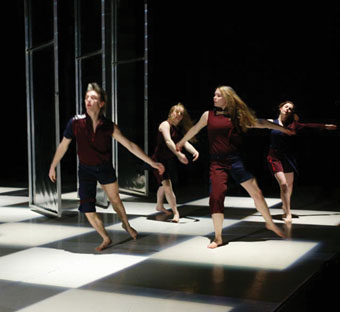Bridging division with design
Sarah Neville: Fiona Malone, D/VISION

Fiona Malone, D/VISION
photo Tony Lewis
Fiona Malone, D/VISION
D/VISION is a new work choreographed by Fiona Malone with second year dance students at the Adelaide Centre for the Arts. The performing arts school has transformed its Xspace theatre with a bilaterally symmetrical design especially created for the performance to reflect the idea of separation and division of people by space.
As the audience enters, each chooses a card from a pack. The colour decides which side of the performance space they sit on. Friends and partners are temporarily separated, then brought together again during the show when they see each other across the space after divisions are removed by the technical crew. For most of the performance friends gaze across the dance floor, sharing the experience in closer cahoots than if they were sitting side by side. Down on the stage the dancers, lit by an under-glow of lights, march in rows and sharply staged formations, filling the space with a sense of discipline.
The choreography is constructed in linear trajectories that crisscross the space. The dancers execute contracted, held movement, the tension caught in their limbs. Their energy is pitched within the ensemble rather than to the audience. Video cameras and handheld video transmitters are employed to reflect the dancers’ interaction with each other and with walls and barriers in rooms elsewhere in the building. These images are then projected on to the divisions in the space. There is an alternation between semi-transparent and opaque screens which later disappear to make way for ensemble choreography and for the audience to better see each other.
Towards the end of the work a projected chess board appears on the floor, demarcating the space, again bringing people face to face across the divide. This contact suddenly seems so much more intimate and personal than side by side communication. Malone uses the analogy in her choreography to dissolve divisions.
The costumes are fashioned along asymmetrical techno military lines reflecting the fashions of the mid-90s and complementing the mostly ambient techno soundscape, punctuated by punk and occasionally happy house music. However, even though placed above the performers, the audience was frustratingly cut off from the sonic environment, with the speakers hung high above the lighting rig.
The dancers performed with control, showcasing their ensemble, vocal and acrobatic skills, bringing their contemporary dance technique to the fore. As the first large-scale choreographic work from South Australian choreographer Fiona Malone, D/VISION was innovative in the connections made between the architecture of its design and a clear conceptual rationale. In 40 minutes we experienced through several mediums the way divisions can also bring people together.
D/VISION, choreographer Fiona Malone, Adelaide Centre for the Arts, September 15-18
RealTime issue #64 Dec-Jan 2004 pg. 34






